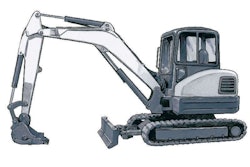
 Consider these tips to find a model that best serves you.
Consider these tips to find a model that best serves you.
Undercarriage
A large part of the cost of buying and maintaining a compact track loader is in its undercarriage, so you’ll want to pay particular attention to this area. Is the undercarriage integrated into the entire machine structure or merely a bolt on design? For example, suspended undercarriages improve the ride for the operator and reduce the shock load going into the machine and undercarriage components.
Also consider maintenance: Is it easy to clean out the undercarriage after a long day in the mud and to keep the tracks properly tensioned?
Boom types
The two basic types are vertical lift and radial lift. If the machine will be used mostly for lift-and-carry applications, a vertical lift machine is likely best. If most work will involve digging, prying up concrete or pushing material, the radial lift machine is a better choice.
Drive speed
A two-speed compact track loader offers higher travel speeds while still allowing low-speed operation, as is required while working. One-speed machines generally result in a compromise of either drawbar pull or travel speed. Make sure the loader has the pushing power you’ll need: Look for terms like “tractive power” or “drawbar pull.” Machines with high numbers here do well using dozer-type attachments.
Controls
Trickle-down of such features as advanced electronics and pilot-control hydraulics from larger machines is making compact track loaders easier to use. Joysticks offer intuitive control during both gross and fine operations, such as digging and finish grading, and they require almost zero effort to use, which equals less operator fatigue at the end of the day.
Serviceability
The undercarriage isn’t the only place where ease of service matters. Look for accessible grease fittings and single-sided engine service as part of an easy-to-maintain approach. Also, consider the value of air pre-cleaners, which will help extend the filter life and reduce maintenance requirements. Check for coolers that are placed side-by-side, rather than stacked. Stacked assemblies are harder to clean because you can’t access both sides of both coolers. They also tend to trap debris between the two coolers.
EDITOR’S NOTE: This article was written by Richard Ries.










